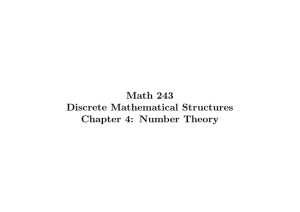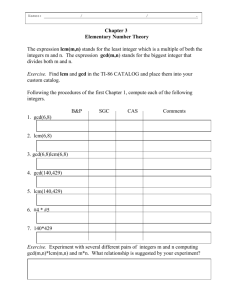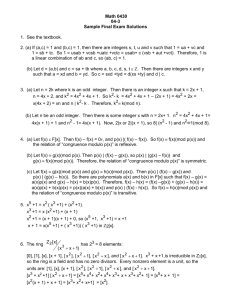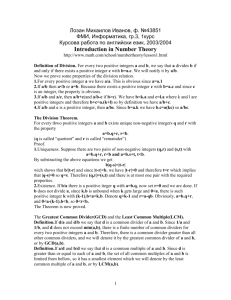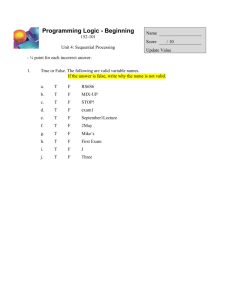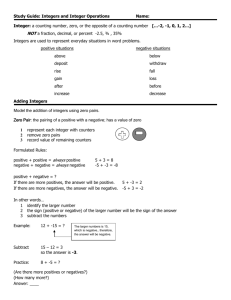Typical Proofs and other notes
advertisement
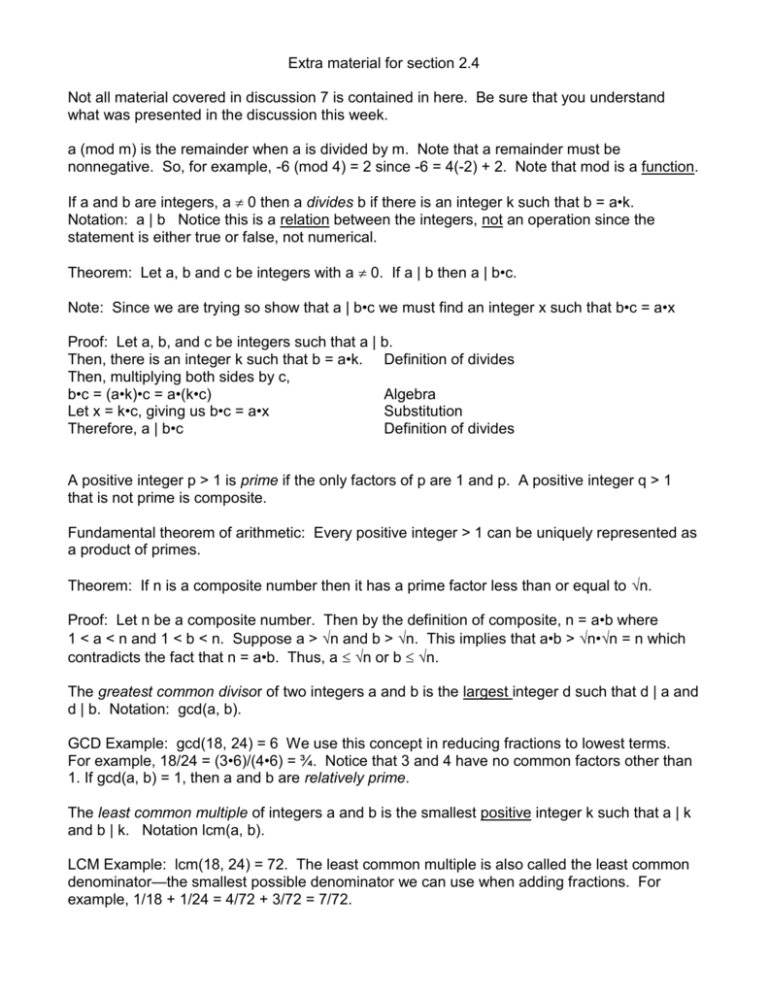
Extra material for section 2.4 Not all material covered in discussion 7 is contained in here. Be sure that you understand what was presented in the discussion this week. a (mod m) is the remainder when a is divided by m. Note that a remainder must be nonnegative. So, for example, -6 (mod 4) = 2 since -6 = 4(-2) + 2. Note that mod is a function. If a and b are integers, a 0 then a divides b if there is an integer k such that b = a•k. Notation: a | b Notice this is a relation between the integers, not an operation since the statement is either true or false, not numerical. Theorem: Let a, b and c be integers with a 0. If a | b then a | b•c. Note: Since we are trying so show that a | b•c we must find an integer x such that b•c = a•x Proof: Let a, b, and c be integers such that a | b. Then, there is an integer k such that b = a•k. Definition of divides Then, multiplying both sides by c, b•c = (a•k)•c = a•(k•c) Algebra Let x = k•c, giving us b•c = a•x Substitution Therefore, a | b•c Definition of divides A positive integer p > 1 is prime if the only factors of p are 1 and p. A positive integer q > 1 that is not prime is composite. Fundamental theorem of arithmetic: Every positive integer > 1 can be uniquely represented as a product of primes. Theorem: If n is a composite number then it has a prime factor less than or equal to n. Proof: Let n be a composite number. Then by the definition of composite, n = a•b where 1 < a < n and 1 < b < n. Suppose a > n and b > n. This implies that a•b > n•n = n which contradicts the fact that n = a•b. Thus, a n or b n. The greatest common divisor of two integers a and b is the largest integer d such that d | a and d | b. Notation: gcd(a, b). GCD Example: gcd(18, 24) = 6 We use this concept in reducing fractions to lowest terms. For example, 18/24 = (3•6)/(4•6) = ¾. Notice that 3 and 4 have no common factors other than 1. If gcd(a, b) = 1, then a and b are relatively prime. The least common multiple of integers a and b is the smallest positive integer k such that a | k and b | k. Notation lcm(a, b). LCM Example: lcm(18, 24) = 72. The least common multiple is also called the least common denominator—the smallest possible denominator we can use when adding fractions. For example, 1/18 + 1/24 = 4/72 + 3/72 = 7/72. General rule for using prime factorization to find the GCD and LCM: to find the gcd, use all primes that appear in both factorizations and use the lowest power of each such prime. To find the lcm, use all primes that appear in either factorization and use the highest power that appear in either one. Suppose a = p2•q3•r5 and b = p•q2•s3. Then gcd(a, b) = p•q2 and lcm(a, b) = p2•q3•r5•s3. Congruence mod m If a and b are integers and m is a positive integer > 1 then a is congruent to b modulo m if m divides a – b. Notation: a b (mod m). (Note: you could also say that m | (b – a)). Notice that this is once again a relation in that it does not provide a numerical answer—it just states whether two integers have the indicated relationship. Example, 6 -4 mod 5 since 5 | (6 - -4) or 5 | 10. Example: Prove that if a, b, and c are integers such that ac | bc then a | b. (Note: that this implies neither a nor c can be 0.) Proof: Suppose ac | bc Then, there is an integer k such that bc = (ac)•k = (ak)•c Since c 0, b = ak Therefore, a | b Definition of divides and algebra Algebra Definition of divides. Example: p. 168 # 42 Show that if a b (mod m) and c d (mod m) then (a – c) (b – d) (mod m) Direct proof: a b (mod m) so integer s such that a – b = m•s or a = b + m•s c d (mod m) so integer t such that c – d = m•t or c = d + m•t Then, a – c = (b + m•s) - (d + m•t) = (b – d) + m•(s – t) So, (a – c) – (b – d) = m•(s – t) Therefore, m | [(a – c) – (b – d)] Therefore, (a – c) (b – d) (mod m) Defn. of congruence Defn. of congruence Algebra Definition of divides Definition of congruence



